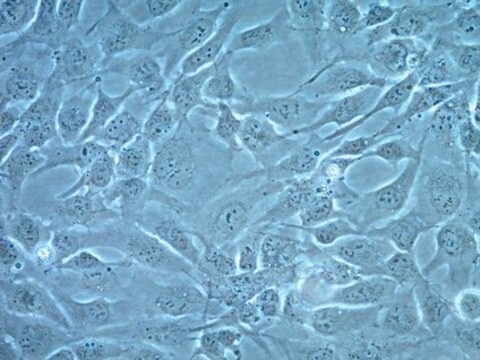SCC065
HL-1 Cardiac Muscle Cell Line
Mouse
Synonym(s):
HL-1 Cardiomyocyte Cell Line, HL-1 Atrial Muscle Cell Line
About This Item
Recommended Products
Product Name
HL-1 Cardiac Muscle Cell Line, HL-1 Cardiac Muscle Cell Line has been extensively characterized and is a valuable model system to address questions of cardiac biology at the cellular & molecular levels.
biological source
mouse
Quality Level
technique(s)
cell based assay: suitable
cell culture | mammalian: suitable
General description
The HL-1 line was derived from AT-1 subcutaneous tumor excised from an adult female C57BL/6J mouse. The parental AT-1 line was originally derived from an atrial tumor growing in a transgenic mouse in which expression of the SV40 large T-antigen was targeted to atrial cardiomyocytes via the atrial natriuretic factor (ANF) promoter.
Cell Line Description
Application
Cardiac
Cardiovascular Disease
Toxicity
Quality
• Cells tested negative for infectious diseases by the Mouse Essential CLEAR panel PCR panel by Charles River Animal Diagnostic Services.
• Cells are negative for mycoplasma contamination.
• Functional Assay: Fluo-8 calcium dye fluorescent based assay for detecting changes in intracellular calcium
Storage and Stability
Disclaimer
This product contains genetically modified organisms (GMO). Within the EU GMOs are regulated by Directives 2001/18/EC and 2009/41/EC of the European Parliament and of the Council and their national implementation in the member States respectively. This legislation obliges {HCompany} to request certain information about you and the establishment where the GMOs are being handled. Click here for Enduser Declaration (EUD) Form.
Storage Class Code
12 - Non Combustible Liquids
WGK
WGK 2
Flash Point(F)
Not applicable
Flash Point(C)
Not applicable
Certificates of Analysis (COA)
Search for Certificates of Analysis (COA) by entering the products Lot/Batch Number. Lot and Batch Numbers can be found on a product’s label following the words ‘Lot’ or ‘Batch’.
Already Own This Product?
Find documentation for the products that you have recently purchased in the Document Library.
Customers Also Viewed
Our team of scientists has experience in all areas of research including Life Science, Material Science, Chemical Synthesis, Chromatography, Analytical and many others.
Contact Technical Service








